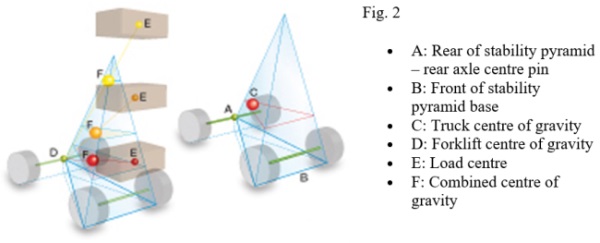Complete Powerpoint slide presentation for forklift instructors. Ready made training course
The mousetrap. Why forklifts tip over
Why forklifts fall
There are many situations that can lead up to a tipping incident, but in all cases the truck’s stability has been compromised by poor driving and poor understanding of the basic principles of forklift stability.
At the heart of truck stability is the so-called Stability Pyramid. Forklift trainers recognise the pyramid as one of the most difficult yet important concepts to teach. A major problem – recognised by health and safety regulators – is that there is not enough training time to ensure this principle is actually understood.
How does the centre of gravity move?

The point that must be kept within the triangle/pyramid is the combined centre of gravity (CCOG). The truck itself has its own centre of gravity, typically about 20cm below the driver’s seat. In addition, the load has a centre of gravity – the load centre – typically 500mm forward of the fork backrest.
These two forces form the combined centre of gravity: a new, moving, centre of gravity that must stay inside the Stability Pyramid. If this point moves beyond the front of the pyramid, the truck will tip forward. If it leaves the pyramid to left or right, the truck will tip sideways.
When stationary, the CCOG can always be found on a line drawn from the truck’s centre of gravity to the load centre – as the load is lifted, the CCOG moves upwards with it – into a smaller and smaller triangle.
Why is it a triangle?
Many forklift drivers struggle with the idea of the base of their stability pyramid being a triangle and not a square with a wheel on each corner – especially on a four wheel forklift. In fact, the pyramid’s base joins the front two wheels on the ground with the pivot point on the rear steer axle – so even on a four wheel truck, it is a triangle, with one point over the rear axle pivot.
Most people think of a ‘pyramid’ as having a square base, like those in Egypt. A triangle-based pyramid is actually called a tetrahedron. Keeping the CCOG inside a triangle is even harder than a square, because it is smaller!
More height, more danger
Because the pyramid rapidly narrows to a point, loads that are very stable at low lift height quickly become unstable at higher lift – as the CCOG must be kept in a smaller and smaller triangle. At high lifts, this triangle can be surprisingly small – with very little margin of error.
More speed, more danger
Unfortunately the centre of gravity is not the only force at work. In a moving truck there are additional forces – caused by the truck’s acceleration and deceleration. Even quite gentle braking can move the effective CCOG forward – out of the triangle – creating the risk of tipping.
Continued, the dynamic forces at work>>
Disclaimer. The legislative information contained on this web site is my interpretation of the law based on many years in the health and safety business. A definitive interpretation can only be given by the courts. I will therefore not be held responsible for any accident/incident/prosecution arising as a consequence of anyone using any information obtained from this web site.